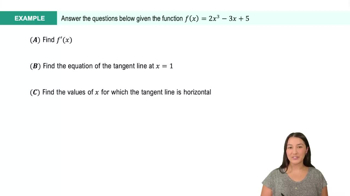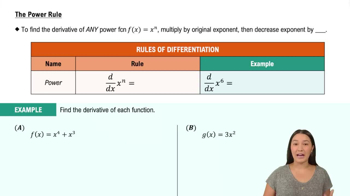Table of contents
- 0. Functions7h 52m
- Introduction to Functions16m
- Piecewise Functions10m
- Properties of Functions9m
- Common Functions1h 8m
- Transformations5m
- Combining Functions27m
- Exponent rules32m
- Exponential Functions28m
- Logarithmic Functions24m
- Properties of Logarithms34m
- Exponential & Logarithmic Equations35m
- Introduction to Trigonometric Functions38m
- Graphs of Trigonometric Functions44m
- Trigonometric Identities47m
- Inverse Trigonometric Functions48m
- 1. Limits and Continuity2h 2m
- 2. Intro to Derivatives1h 33m
- 3. Techniques of Differentiation3h 18m
- 4. Applications of Derivatives2h 38m
- 5. Graphical Applications of Derivatives6h 2m
- 6. Derivatives of Inverse, Exponential, & Logarithmic Functions2h 37m
- 7. Antiderivatives & Indefinite Integrals1h 26m
- 8. Definite Integrals4h 44m
- 9. Graphical Applications of Integrals2h 27m
- 10. Physics Applications of Integrals 2h 22m
3. Techniques of Differentiation
Basic Rules of Differentiation
Problem 3.2.23b
Textbook Question
21–30. Derivatives
b. Evaluate f'(a) for the given values of a.
f(x) = 4x²+1; a= 2,4
 Verified step by step guidance
Verified step by step guidance1
Step 1: Identify the function f(x) = 4x^2 + 1 and the values of a for which we need to evaluate the derivative, which are a = 2 and a = 4.
Step 2: Find the derivative of the function f(x) with respect to x. Use the power rule, which states that the derivative of x^n is n*x^(n-1).
Step 3: Apply the power rule to f(x) = 4x^2 + 1. The derivative of 4x^2 is 8x, and the derivative of the constant 1 is 0.
Step 4: Write the derivative function f'(x) = 8x.
Step 5: Evaluate the derivative at the given values of a. Calculate f'(2) by substituting x = 2 into f'(x), and calculate f'(4) by substituting x = 4 into f'(x).
 Verified video answer for a similar problem:
Verified video answer for a similar problem:This video solution was recommended by our tutors as helpful for the problem above
Video duration:
5mPlay a video:
Was this helpful?
Key Concepts
Here are the essential concepts you must grasp in order to answer the question correctly.
Derivatives
A derivative represents the rate of change of a function with respect to its variable. It is a fundamental concept in calculus that provides information about the slope of the tangent line to the curve of the function at any given point. The derivative is denoted as f'(x) and can be calculated using various rules, such as the power rule, product rule, and quotient rule.
Recommended video:

Derivatives
Power Rule
The power rule is a basic differentiation rule used to find the derivative of functions in the form f(x) = x^n, where n is a real number. According to this rule, the derivative f'(x) is calculated as n*x^(n-1). This rule simplifies the process of differentiation, especially for polynomial functions, making it easier to evaluate derivatives at specific points.
Recommended video:
Guided course

Power Rules
Evaluating Derivatives at Specific Points
Evaluating the derivative at a specific point involves substituting the value of that point into the derivative function. For example, if f'(x) is found, to evaluate f'(a) for a given value of a, simply replace x with a in the derivative expression. This process yields the instantaneous rate of change of the function at that particular point, providing insights into the function's behavior.
Recommended video:

Critical Points

 3:59m
3:59mWatch next
Master Derivatives of Linear Functions with a bite sized video explanation from Callie
Start learningRelated Videos
Related Practice







